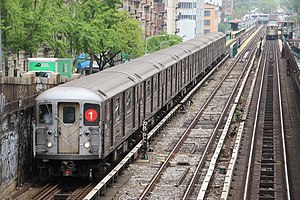
New York City Subway
Rapid transit system in New York City / From Wikipedia, the free encyclopedia
Dear Wikiwand AI, let's keep it short by simply answering these key questions:
Can you list the top facts and stats about New York City Subway?
Summarize this article for a 10 years old
The New York City Subway is a rapid transit system in the New York City boroughs of Manhattan, Brooklyn, Queens, and the Bronx. It is owned by the government of New York City and leased to the New York City Transit Authority,[15] an affiliate agency of the state-run Metropolitan Transportation Authority (MTA).[16] Opened on October 27, 1904, the New York City Subway is one of the world's oldest public transit systems, one of the most-used, and the one with the most stations,[17] with 472 stations in operation[18] (424, if stations connected by transfers are counted as single stations).[1]
| New York City Subway | |||
|---|---|---|---|
 | |||
 Top: A 1 train made up of ten R62A cars leaves the 125th Street elevated station bound for South Ferry, with another going to 242 Street. Bottom: An E train made up of ten R160A cars enters the 42nd Street–Port Authority Bus Terminal station. | |||
| Overview | |||
| Owner | City of New York | ||
| Area served | The Bronx, Brooklyn, Manhattan, and Queens | ||
| Locale | New York City | ||
| Transit type | Rapid transit | ||
| Number of lines | 36 lines[note 1] 28 services (1 planned)[note 2] | ||
| Number of stations | 472[1] (MTA total count)[note 3][note 4] 424 unique stations[note 4][1] (when compared to international standards) 14 planned[note 3] | ||
| Annual ridership | 1,793,073,000[6]: 2 [note 5] (2022) | ||
| Website | new | ||
| Operation | |||
| Began operation | October 27, 1904; 118 years ago (1904-10-27) (Original subway) July 3, 1868; 155 years ago (1868-07-03)[8] (first railroad operation)[note 6] | ||
| Operator(s) | New York City Transit Authority (NYCTA) | ||
| Number of vehicles | 6,418[9] | ||
| Headway | Peak hours: 6–12 minutes[10] Off-peak: 12–20 minutes[10] | ||
| Technical | |||
| System length | 248 mi (399 km)[11] (route length) 665 mi (1,070 km)[11] (track length, revenue) 850 mi (1,370 km)[12] (track length, total) | ||
| Track gauge | 4 ft 8+1⁄2 in (1,435 mm) standard gauge[12] | ||
| Electrification | Third rail, 600–650 V DC (normally 625V)[12][13] | ||
| Average speed | 17.4 mph (28.0 km/h)[14] | ||
| Top speed | 55 mph (89 km/h)[14] | ||
| |||
The system has operated 24/7 service every day of the year throughout most of its history, barring emergencies and disasters. By annual ridership, the New York City Subway is the busiest rapid transit system in both the Western Hemisphere and the Western world, as well as the eleventh-busiest rapid transit rail system in the world.[19] The subway carried 1,793,073,000 riders in 2022.[6]: 2 [note 5] On October 29, 2015, more than 6.2 million people rode the subway system, establishing the highest single-day ridership since ridership was regularly monitored in 1985.[20]
The system is also one of the world's longest. Overall, the system contains 248 miles (399 km) of routes,[11] translating into 665 miles (1,070 km) of revenue track[11] and a total of 850 miles (1,370 km) including non-revenue trackage.[12] Of the system's 28 routes or "services" (which usually share track or "lines" with other services), 25 pass through Manhattan, the exceptions being the G train, the Franklin Avenue Shuttle, and the Rockaway Park Shuttle. Large portions of the subway outside Manhattan are elevated, on embankments, or in open cuts, and a few stretches of track run at ground level. In total, 40% of track is above ground.[21] Many lines and stations have both express and local services. These lines have three or four tracks. Normally, the outer two are used by local trains, while the inner one or two are used by express trains. Stations served by express trains are typically major transfer points or destinations.
As of 2018[update], the New York City Subway's budgetary burden for expenditures was $8.7 billion, supported by collection of fares, bridge tolls, and earmarked regional taxes and fees, as well as direct funding from state and local governments.[22]
